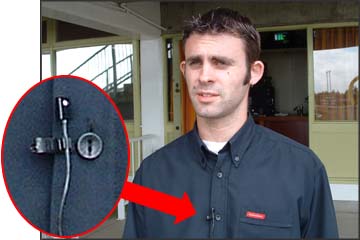Microphone Stands, Mounts & Clamps
An important consideration is the way the microphone is held or mounted. A poorly mounted mic can lead to all sorts of problems, whereas a well-mounted mic can lift the audio quality significantly. Things to consider when mounting a mic include:
- The mic obviously needs to be correctly positioned, facing the required direction. You should be able to reposition the mic if necessary.
- The mic must be safe, i.e. Won't fall over, get knocked, get wet, etc.
- The mic must be shielded from unwanted noise such as handling noise, vibrations, wind, etc.
- Cables must be secure and safe. In particular, make sure no one can trip over them.
 Boom Stand |
 Tabletop Stand |
There are many ways to mount microphones. Let's look at the most common methods...
Microphone Stands
The most obvious mount is the microphone stand. There are three main variations: The straight vertical stand, the boom stand and the small table-top stand.
Boom stands are very useful and versatile. If you are considering buying a general-purpose stand, a boom stand is the logical choice.
Some things to watch out for when setting up a microphone stand:
- Always position the boom to extend directly above one of the stand legs. This prevents the stand from tipping over.
- Don't wrap the lead a hundred times around the stand. This serves no purpose except make your life difficult and possibly increase twisting pressure on the lead. One turn around the vertical part of the stand and another turn around the boom is all you need.
- Never stand on the legs. You will wreck them.
- Never over-tighten clamps. Do them up until until they are firm - no more. Don't try to adjust clamps while they are tightened - undo them first.
Note: Boom arms controlled by sound operators will be covered on the next page.
Clamps
Instead of using a dedicated mic stand, you can use a specialised clamp to piggyback on another stand (or any other object).
Advantages:
- Less floor space is used, more mics can be squeezed into the same area.
- Less equipment to carry (clamps are smaller and lighter than stands).
- Can sometimes be useful reaching difficult positions.
Disadvantages:
- Can sometimes be tricky to set up and more difficult to get exactly the right positioning. Also more difficult to move or adjust once set up.
- More likelihood of unwanted vibration noise creeping into the mix.
Clamps are often used in musical situations where there are many stands and many microphones. The classic example is the drum kit which is surrounded by cymbal stands - clamps are well suited to this application.

Clothing Clip
Lavalier (lapel or lap) mics are usually attached to the subject's clothing using a specialised clip. Obviously the preferred position is on the lapel or thereabouts. This provides consistent close-range sound pickup and is ideal for interview situations in which each participant has their own mic. It also means the subject doesn't have to worry about mic technique.
If you have time, discreetly hide the cable in the clothing. If there is nowhere to place the mic on the subject's chest, try the collar.
Headset
A headset with its own mic works well in situations such as:
- When the person talking needs to listen as well as speak.
- When the person talking must be able to move around with their hands free.
- When there is a lot of background noise, likely to be distracting the the subject.
Headsets are ideal for stage performers, as well as sports commentators, radio announcers, etc. Like lav mics, they provide very consistent audio.
Shock Absorption
In order to minimise unwanted noise caused by vibration of the stand or mount, a shock absorption system may be used. This isolates the mic from the vibrations, usually with foam padding or elastic suspension.
Next Page: Microphone Booms